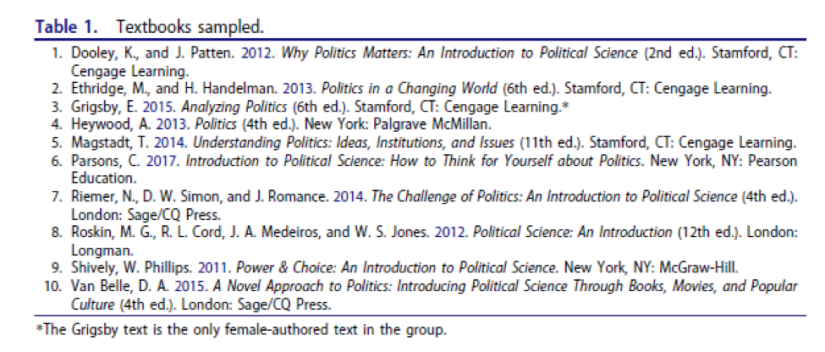In a guest post for the PSA Women and Politics Blog, Amy Atchison (Valparaiso University) asks the crucial question of ‘where are the women’ in political science textbooks. Her research finds that gendered content in introductory political science texts is scarce and the quality of that content varies considerably, thus continuing to signal to students that women and gender are not part of the ‘mainstream’ of political science.
Despite for gender mainstreaming in political science education, evidence indicates that very little mainstreaming is taking place. This is likely related to a knowledge gap regarding politics and gender. As Ernest Boyer noted: “[A]s a scholarly enterprise, teaching begins with what the teacher knows.” Nevertheless, professors would be hard-pressed to know everything there is to know about their discipline. Plus, we do not typically have the time and resources to create class materials from scratch. Instead, we often rely on textbooks to help shape course content, and the textbooks we choose often provide students’ first exposure to a discipline. I argue that the central challenge to effective gender mainstreaming in the political science classroom lies with the lack of substantive gendered content in existing textbooks.
Why do Textbooks Matter?
Textbooks are an integral part of the . Indeed, textbooks teach particular that shape students’ disciplinary worldview. Textbooks reproduce scientific knowledge for the student audience and shape not just what students think about a subject but how they think about it. The information in the book demonstrates to students what practitioners consider “legitimate” knowledge in the field, which means it is important to note that what is left out of textbooks is just as important as what is put in them. What is left out sends a very clear message to students about who (white male elites) and what (institutions) are important in political science.
The research on gender content in political science indicates that gender-related content is limited in government texts. The research has primarily focused on American government texts, so it is no surprise that gendered content is most often found in chapters that address civil rights. If textbooks tend to drive our curriculum and curriculum is “constituted as a normalizing text,” then the evidence indicates that gender is not being normalized in introductory American government classes. The question is whether or not there is a similar lacuna in other introductory areas of political science education. I am particularly concerned about introductory political science texts because an introductory class typically exposes students to political theory/ideologies, regime types, institutions, and political participation. This matters because in an increasingly globalized society, how gender-related information is presented to students sets the tone for how they view women’s issues both domestically and globally.
Do introductory political science texts contain basic information about gender and politics?
The 10 textbooks (Table 1, below) included in my study* contain relatively little content related to women and politics. I determined this by examining each textbook’s use of 9 search terms:
- Women/Women;
- Female/Females;
- Feminism/Feminist;
- Girl/Girls;
- Gender
I classified mentions as either substantive or non-substantive. Non-substantive references include terms such as men and/or women, men or women, women and minorities, male and/or female, etc., without any analytic import. The results demonstrate that almost 82% of the total mentions of the search terms are substantive. “Women” is the most commonly used term, and it is largely used substantively; this is consistent with American government texts. In contrast, although researchers have found that “feminism” is not a widely used term in American government texts, I find that feminism is the second-most used of the search terms in introductory political science texts, with 91% of the mentions being substantive.

Where in the textbook is that information located?
Unlike American government texts, introductory political science texts don’t typically have civil rights chapters—but they do usually have chapters on political theory and/or ideologies. As one might expect, there are large concentrations of gender-related content in these theory/ideology chapters —33% of all mentions and 36% of substantive mentions of the search terms. Moreover, the prevalence of the search terms in chapters on theory or ideology is common to all 10 texts in the study. This provides very strong evidence that segments on feminism drive a considerable amount of the gendered content in Introduction to Political Science texts.
Unexpectedly, there are also relatively large concentrations of gendered terminology in chapters dealing with political participation—this includes chapters related to parties, groups, movements, and/or elections; these content areas account for nearly 22% of the total mentions of the search terms and nearly 23% of the substantive mentions. In total, just the two categories discussed here (theory/ideology and political participation) account for about 54% of all mentions of the search terms and almost 59% of all substantive mentions. Importantly, the same 54% of all mentions of the search terms are found on just 182 pages out of the 4896 pages examined in this study. The fact that 54% of mentions are found on just 3.7% of pages indicates an extraordinary level of concentration of the terms. If gender were truly mainstreamed in these texts, the substantive references would be more plentiful and spread across more locations in each text.
How is gendered content presented in the texts?
Treatments of the search terms vary wildly amongst the texts. This is quite evident in the very different treatments of feminism in the textbooks included in this study. Grigsby, for example, has included a thorough and nuanced portrait of the feminist spectrum. In contrast, Magstadt has just one substantive mention of feminism in the entirety of the textbook, and Van Belle’s treatment of feminism is so lacking that the word “feminism” does not actually appear in the text (“feminist” does).
The variation in the treatment of women’s political participation is similar. With reference to parties and elections, most of these texts address the gender gap in policy preferences, voting, and representation. They typically include the reversal in ideological preference (from right-leaning to left-leaning) among Western women, as well as the fact that women now tend to vote in larger numbers than their male counterparts. In terms of representation, most authors mention that women are underrepresented in elected office but offer very little in the way of explanation for this, and only two (Parsons and Etheridge & Handelman) offer a substantive discussion of gender quotas. While this lacuna is unfortunate, I prefer the authors’ benign neglect of gender and representation over Heywood’s overt hostility to the topic.
The entirety of the descriptive representation section of the Heywood text was so patently incorrect and hostile that I felt compelled to protest. Heywood characterizes descriptive representation as dangerous to democracy and restrictive of individual freedom. He presents his claims as objective fact, yet presents no evidentiary basis for his assertions. With the backing of the PSA’s Women and Politics Specialist Group, as well as the APSA Committee on the Status of Women, the ECPR Gender and Politics Standing Group, and the ISA Gender Politics and Policy Group, I wrote Palgrave to ask that they ensure that the next edition of the textbook contain an accurate depiction of both the concept of descriptive representation and the related research. To their credit, the publisher and author agreed to change the text and asked me to review the next edition (due this year).
No matter how well (or poorly) the authors incorporate gender as an analytic construct, the fact remains that—in these texts—the substantive information about women is largely relegated to chapters related to theory and ideologies, as well as parties, groups, movements, and elections. This serves to marginalize information about women and politics and demonstrates to students that gender and politics are a separate or unique issue that has no place in the mainstream. That said, it is important to think about what a good gender-mainstreamed textbook would look like. This raises dozens of questions, ranging from the complete reimagining of introductory textbooks to how best to demonstrate the compounding effects of race, class, and gender. All of these issues boil down to one main question: How do we create textbooks that accurately and fairly depict the diversity of social forces at play in modern political systems?
*If you do not have access to the Journal of Political Science Education, the post-acceptance/pre-publication version of my article is posted here.

Amy Atchison is Associate Professor of Political Science and International Relations at Valparaiso University.